 |
Gabions, Fascines, and Bales of Wool |
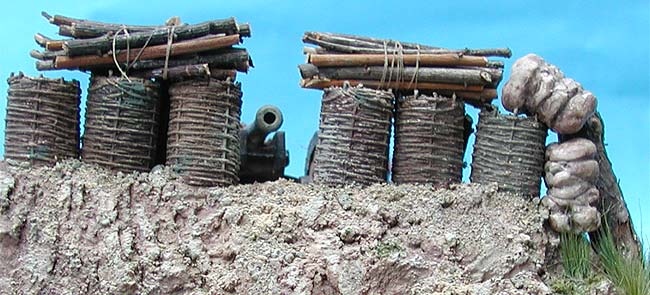
Shown protecting this artillery position are all
three articles: gabions, fascines and bales of wool. One could
have found any two used together but it was probably rare to have
found
all three together.
Click here to see what is what, and doubleclick that link to return to this image.
Protection for infantry and artillery was handily provided with gabions, fascines and bales of wool. Portable, these were made and deployed in little time wherever the enemy placed his fire. These supplemented fixed defenses, say, a row of gabions atop a parapet or in front of the covered way. They were also thrown up to create temporary works. Although included in this portion of the Web site, these items were as much used (and often more so) by the attackers to shield their trenches as they dug toward the fort.
Basically, the three functioned to absorb small arms fire, canister shot, and perhaps the small-bore cannonball that was mostly spent in its trajectory. But something like a 24-pounder could have turned a gabion into a shower of dirt and broken rock.
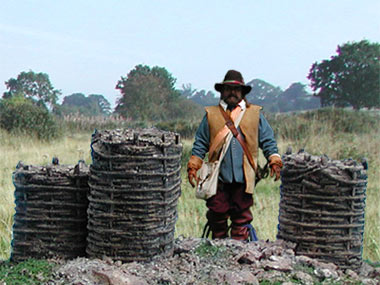 Gabions
were woven in various sizes. Usually, they were open at both
ends, and the vertical rods extended a several inches from one of
the ends and were sharpened to anchor in the ground. Set on
that end, the "basket" was filled with dirt and
rocks, which could have been right out of the trench being
constructed. Once filled, they became immobile but were
sturdy, affording protection - as long as one did not stand in any
gap between two. For that contingency, gabions were
occasionally arranged in two closely spaced rows, alternating with
one another. They were also stacked one atop another, if the
basket makers were producing short ones. No period
illustration shows, however, more than two tiers of gabions. The
modern-day replacement is the sandbag.
Gabions
were woven in various sizes. Usually, they were open at both
ends, and the vertical rods extended a several inches from one of
the ends and were sharpened to anchor in the ground. Set on
that end, the "basket" was filled with dirt and
rocks, which could have been right out of the trench being
constructed. Once filled, they became immobile but were
sturdy, affording protection - as long as one did not stand in any
gap between two. For that contingency, gabions were
occasionally arranged in two closely spaced rows, alternating with
one another. They were also stacked one atop another, if the
basket makers were producing short ones. No period
illustration shows, however, more than two tiers of gabions. The
modern-day replacement is the sandbag.

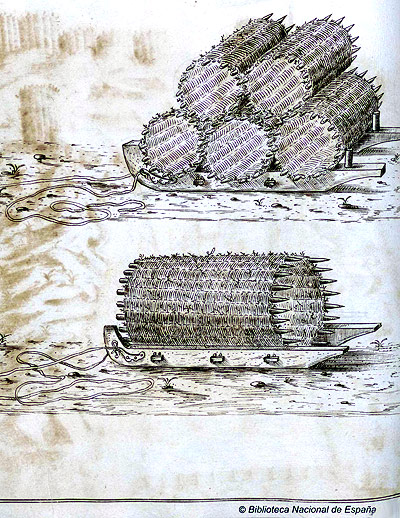 Gabions could be made off site and then transported where needed (safer for those making them) or made onsite. For either, the vertical stakes were pounded into the ground, then the inside filled.
Gabions could be made off site and then transported where needed (safer for those making them) or made onsite. For either, the vertical stakes were pounded into the ground, then the inside filled.
Instead of a second tier of gabions, sticks and wood tied together in
bundles could be laid atop gabions. These were fascines and
could be made quickly by any soldier, unlike gabions that were
woven by those with basketmaking skills. A portability
drawback to gabions was they became immobile once filled (unless
unfilled), whereas fascines could be picked up to be moved to
another site. 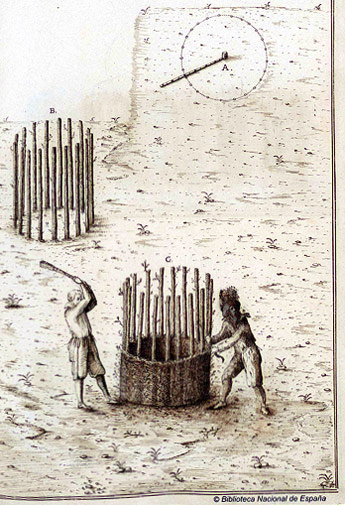 Of course, fascines were also used by themselves,
sometimes stacked several deep or even racked on their ends.
Fascines typically were one to two meters long, but some, called
saucissions or sausages, were as long as five meters, used atop
parapets.
Of course, fascines were also used by themselves,
sometimes stacked several deep or even racked on their ends.
Fascines typically were one to two meters long, but some, called
saucissions or sausages, were as long as five meters, used atop
parapets.
Wool bales at first seem a curious sort of shield. Thinking beyond Little Bo Peep and cuddly lambs, a fat bundle of wool densely packed would absorb a musket ball as well as a gabion. Furthermore, in some areas wool bales could have been easily had. Wool production, especially in the 17th century, was an expanding industry and wool actively traded. Some towns could have had sheds and warehouses stacked with bales. One wonders, though, about the market value of any wool bale after it was shot up in a siege.
.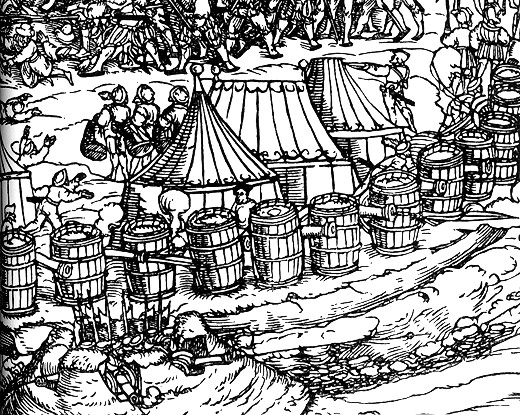
Considering the resemblance of a gabion to a barrel, were barrels used for defensive protection? At the Siege of Buda in 1541, barrels were set up along the perimeter of the besieged, who were Landsknecht fighting a Turkish army. Barrels were filled with (likely) earth and provied cover for cannon.
But there are few references to barrels shielding defenders. A probable reason for the dearth: barrels were expensive. Only skilled labor (coopers) could make barrels, using select woods they carefully shaped then assembled. On the other hand, gabions were made by, at best, semi-skilled labor with materials found nearby, like reeds from the riverside. Fascines could be made by anyone who could gather sticks, then wind a little cord around bundles of them.
###
With the art of fort design and construction so thoroughly developed to withstand cannon fire and assaults, could an artillery fort be taken? O-o-oh, yes! Let's discover how and why in Part II
| Back |
Part II: The Attack |
|
|
|